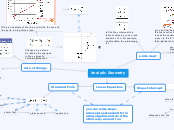によって Mainal Lodhra 7年前.
971
Math Summative

によって Mainal Lodhra 7年前.
971

もっと見る
Gives us the x-intercept and y-intercept quickly.
x-term first
y-term second
equals to 0
No fractions
Gives the initial value
Graphs line quickly
Gives the rate of change
m = multiplier
(x,0)
Slope
Steepness of a line